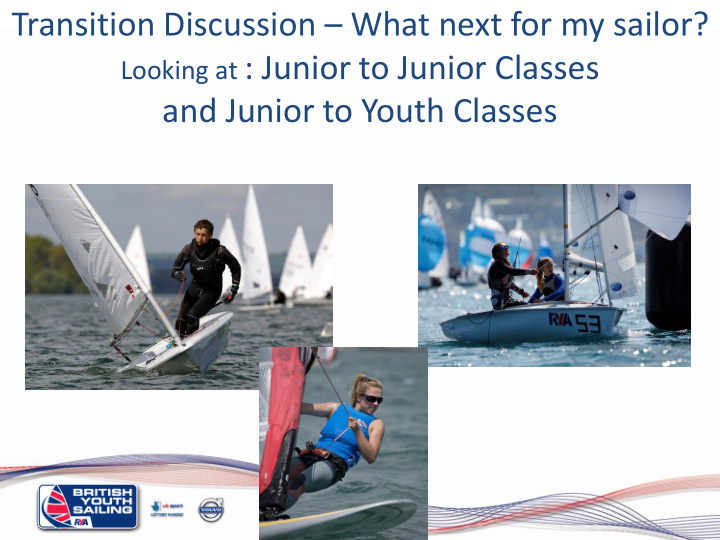



Transition Discussion – What next for my sailor? Looking at : Junior to Junior Classes and Junior to Youth Classes
Page 6 and 7 To develop & retain the best young racing sailors in the world
To achieve the ambition: 1. Create fast sailors in all conditions. 2. To develop mentally and physically robust athletes who are resilient in the most testing conditions. 3. To develop excellent non-dependent decision- makers . 4. To develop sailors that excel under extreme pressure . 5. Nurture passion , professionalism and a performance mind-set Such that we… Embed British Sailing Team values and behaviours from the outset
Page 14 and 15
Page 10-13 3. The journey
Junior Classes
Why look to change Junior Class • Sailors growing - become too tall and/or too heavy to be competitive in their current class • May prefer to sail doublehanded v’s singlehanded • Age • Friendships
Maturation /Growth Spurt
Considerations for new Class • Can accommodate changing physiology of your growing sailor • Singlehanded/Doublehanded, Crew/Helm • Social aspect (appropriate for your sailor)
Common Junior 2 Junior Transitions
Common Junior 2 Junior transitions
Common Junior 2 Junior transitions
Junior to Youth
Junior 2 Youth Windsurfers
Junior 2 Youth – Considerations • Age • Height and weight for Youth classes • Singlehanded v’s doublehanded • Same sex crew/mixed crew • Crew or Helm
Crewing • Lots to learn! – Spinnaker – Trapeze – Communication – Jib – Partnership
“Partnerships” • Aspirations – Sailors – Parents • Location • Training & Racing • Managing the team • Budgeting the budget • Coaching
Laser Radial Type: Single-hander Weight Range: 60-72kg
420 Type: Double Hander Weight Range: 105-130kg
29er Type: Double Hander Weight Range: 110-130kg
Nacra 15 Type: Double Hander Weight Range: TBC
RS:X Type: Singlehander (Windsurfer) Weight Range: 55kg +
T1 Programme (transition) • Open to all junior sailors as they exit junior classes and are moving into youth classes for the first time. • A Support Programme to aid the learning of sailors as they exit from junior classes and move to youth classes. • Delivered through class associations/open training (nationally) and also delivered locally through Zone/regional and Home Country activity
The T1 Process 1. Intention to Transition registration process opens in June/July. 2. Registrations reviewed in August. 3. T1 programme begins in September (delivered through Class Association Open training). Don’t forget to also register direct with relevant Class Association (and pay them!!)
RYA High Performance Managers Duncan West: South & SW 07747 111447 duncan.west@rya.org.uk Paul Wren: East & London and South East 07909 994641 paul.wren@rya.org.uk Chris Blackburn: North & Midlands 07909 994637 chris.blackburn@rya.org.uk
Home Countries Northern Ireland, Scotland and Wales have a different policy and training system. For details of their programmes, please contact the following people: Wales Paul Simes 07823 338374 paul.simes@ryacymruwales.org.uk Scotland Abbie Hewitt 07786 333541 abbie.hewitt@ryascotland.co.uk N. Ireland Matt McGovern 07384 253526 Matthew.McGovern@rya.org.uk
Any Questions?
Recommend
More recommend